
Wuxi is a city in southern Jiangsu province, eastern China, 135 kilometers (84 mi) by car to the northwest of downtown Shanghai, between Changzhou and Suzhou, and one of the central cities in the Yangtze River Delta. It is the ancient founding capital of the state of Wu, The birthplace of Wu culture. As of the 2020 census, the city had a total population of 7,462,135 inhabitants.
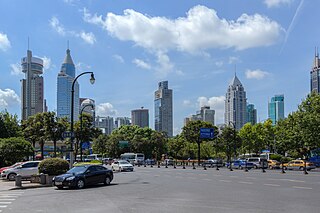
Huangpu District, makes up the eastern part of Shanghai's traditional urban core and is today the most central of Shanghai's 16 districts. Huangpu district is the seat of municipal government, includes key attractions such as The Bund and the Old City God Temple, as well as popular shopping districts such as Nanjing Road, Huaihai Road, and Xintiandi. The Huangpu District is one of the most densely populated urban districts in the world.

The Bund is a waterfront area and a protected historical district in central Shanghai. The area centers on a section of Zhongshan Road within the former Shanghai International Settlement, which runs along the western bank of the Huangpu River in the eastern part of Huangpu. The area along the river faces the modern skyscrapers of Lujiazui in Pudong. The Bund usually refers to the buildings and wharves on this section of the road, as well as some adjacent areas. This region has a significant European influence, with the style of many structures most comparable to that of European cities, particularly Gothic, Baroque, Neoclassical, Romanesque, Art Deco, and Renaissance architecture. Additionally, some of the city's top eateries are located there. From the 1860s to the 1930s, it was the rich and powerful center of the foreign establishment in Shanghai, operating as a legally protected treaty port.

Thomas Alexander Heatherwick, is an English designer and the founder of London-based design practice Heatherwick Studio. He works with a team of more than 200 architects, designers and artisans from a studio and workshop in King's Cross, London.

Nanjing Road is a road in Shanghai, the eastern part of which is the main shopping district of Shanghai. It is one of the world's busiest shopping streets, along with Fifth Avenue, Oxford Street, Orchard Road, Takeshita Street and the Champs-Élysées. The street is named after the city of Nanjing, capital of Jiangsu province neighbouring Shanghai, and the former national capital of the Republic of China. Today's Nanjing Road comprises two sections, Nanjing Road East and Nanjing Road West.

The Peace Hotel is a hotel on The Bund in Shanghai, China, which overlooks the surrounding areas. The hotel has two different buildings. The Sassoon House, originally housed the Cathay Hotel and is today the Fairmont Peace Hotel run by Fairmont Hotels and Resorts of Canada. The South Building was built as the Palace Hotel and is today a residence and studio for artists, known as The Swatch Art Peace Hotel. The two buildings both face the Bund, but are divided by Nanjing Road.

People's Square is a large public square in the Huangpu District of Shanghai. It is south of Nanjing Road (West) and north of Huaihai Road (East).
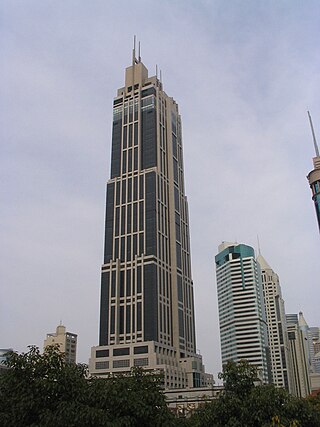
K11 is a shopping mall, located on Huaihai Lu of the Xintiandi district, in the former Luwan District of Shanghai, China. It is 278 m high and was designed by Bregman and Hamann Architects. The mall consists of six stories above ground, and three underground, with a total area of about 40,000 m2. It overlooks the People's Square across the Yan'an Elevated Road. Formerly called the Hong Kong New World Tower, the building was reopened on May 28, 2013, as K11.
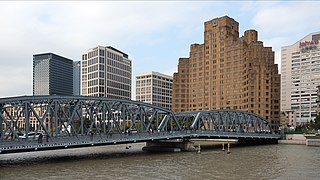
The Waibaidu Bridge, called the Garden Bridge in English, is the first all-steel bridge, and the only surviving example of a camelback truss bridge, in China. The present bridge is the fourth Western-designed bridge built at its location since 1856, in the downstream of the estuary of the Suzhou Creek, near its confluence with the Huangpu River, adjacent to the Bund in central Shanghai. It connects the Huangpu and Hongkou districts and was opened on 20 January 1908. With its rich history and unique design the Waibaidu Bridge is one of the symbols of Shanghai. Its modern and industrial image may be regarded as the city's landmark bridge. On 15 February 1994 the Shanghai Municipal Government declared the bridge an example of Heritage Architecture, and one of the outstanding structures in Shanghai. In an ever-changing metropolis, the Waibaidu Bridge still remains a popular attraction, and one of the few constants in the city skyline.

The Suzhou Museum is a museum of ancient Chinese art, paintings, calligraphy and handmade crafts in Suzhou, Jiangsu, China. It is one of the most visited museums in the world, with more than 2 million visitors in 2018. The Folk Branch of the museum is at the Bei family ancestral temple near Lion Grove Garden. The Western New Pavilion was designed by renowned architect I.M. Pei and was completed and opened in 2006.
Sheffield, England, has a large population of amateur, working and professional visual artists and artworks.

The Central Academy of Fine Arts is the only institution of higher education for fine arts under the direct charge of the Ministry of Education of China. The Manila Bulletin calls the school "China’s most prestigious and renowned art academy." It is one of the most selective universities in the country and turns away more than 95% of applicants every year. The acceptance rate was only 1.58% in 2019. Central Academy of Fine Arts is included in the Chinese state Double First-Class Construction as a Double First Class University. Central Academy of Fine Arts was the first national school of fine arts in Chinese history, and also the beginning of Chinese modern education of fine arts. Since its establishment in 1918, it has produced many notable Artists.

The North China Daily News Building is a historical Neo-Renaissance-style office building on the Bund in Shanghai, China located at No.17, The Bund. It currently houses the offices of the American International Assurance (AIA), and is thus often called the AIA Building. At the time of its opening in 1924, it was the tallest building in Shanghai.
Island6 Arts Center is an artist-run space and creative platform established in Shanghai, China. It was founded in 2006 by French curator/artist Thomas Charvériat.

The Former Consulate-General of the United Kingdom (英国驻上海总领事馆) building located in Shanghai, China, is one of the oldest buildings on the Bund.
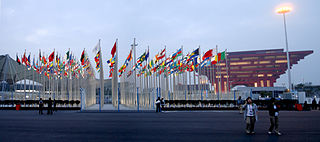
This article contains the details of the pavilions at Expo 2010. The 2010 World Expo Shanghai is the largest Expo site ever, covering more than 5.2 square kilometers and containing more than 70 exposition pavilions. More than 190 countries and 50 international organizations registered to participate in the 2010 Shanghai Expo. After the six-month run, the Expo had attracted well over 70 million visitors. The Expo 2010 is also the most expensive fair in the history of the World's Fair, with more than 45 billion US dollars invested by the Chinese Government.

The Shanghai Exhibition Centre or the Shanghai Exhibition Hall is an exhibition and convention centre in central Shanghai. The building was built in 1955 as the Sino-Soviet Friendship Building to commemorate the alliance between China and the Soviet Union, a name by which many locals still refer to the building. Reflecting its original name, the design draws heavily on Russian and Empire style neoclassical architecture with Stalinist neoclassical innovations.

The National Taiwan Museum of Fine Arts is a museum in West District, Taichung, Taiwan. NTMoFA was established in 1988 and is the first and the only national-grade fine arts museum in Taiwan. The major collections are works by Taiwanese artists, covering modern and contemporary Taiwanese arts. The museum covers 102,000 square meters, including the Public Outdoor Sculpture park, making it one of the largest museums in Asia.
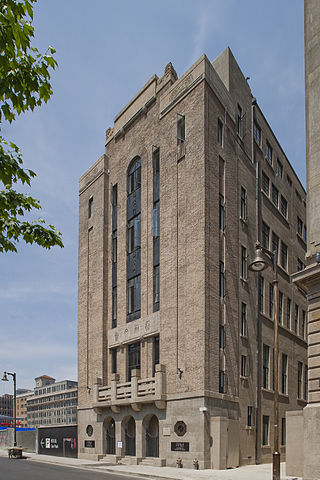
The Rockbund Art Museum is a contemporary art museum in central Shanghai. The museum is on Huqiu Road, in the former Royal Asiatic Society building completed in 1933 near The Bund waterfront. The museum is dedicated to being an influential, innovative, sustainable organization devoted to the promotion of projects within the field of international contemporary art. There are no permanent collections. Featured Chinese artists have included Cai Guo-Qiang and Zeng Fanzhi.

SOHO China is a Chinese building developer, primarily in the office and commercial sector, with some residential and mixed-use properties in its portfolio. The company, which uses the name "SOHO" in both English and Chinese contexts, was founded in 1995 by Chairman Pan Shiyi (潘石屹) and CEO Zhang Xin (张欣). The name SOHO comes from the phrase "Smart Office, Home Office" as the company decided to combine office rooms and residential apartments in the same building to facilitate a comfortable and productive environment.

















